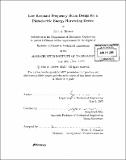| dc.contributor.advisor | Sang-Gook Kim. | en_US |
| dc.contributor.author | Brewer, John A. (John Adam) | en_US |
| dc.contributor.other | Massachusetts Institute of Technology. Dept. of Mechanical Engineering. | en_US |
| dc.date.accessioned | 2006-05-15T20:36:13Z | |
| dc.date.available | 2006-05-15T20:36:13Z | |
| dc.date.copyright | 2005 | en_US |
| dc.date.issued | 2005 | en_US |
| dc.identifier.uri | http://hdl.handle.net/1721.1/32874 | |
| dc.description | Thesis (S.B.)--Massachusetts Institute of Technology, Dept. of Mechanical Engineering, 2005. | en_US |
| dc.description | Includes bibliographical references (leaf 24). | en_US |
| dc.description.abstract | The TREAD Act of 2000 proposed rules that will soon make tire pressure sensors standard on all automobiles. The trend seems to be for small chips that can be imbedded in tires and perform sensing, signal processing, and RF transmission in one package. But powering these devices will be another challenge that must be addressed. This project deals with powering these sensors by harvesting environmental vibrational energy and eliminating the need for batteries. Using MEMS technology, a thin film Piezoelectric Micropower Generator device could be constructed. The PMPG is simply a cantilever structure tuned to resonate at environmental frequencies. At resonance, sizable strain is induced in a layer of the beam made from the piezoelectric material, PZT, thereby generating electricity. Recent studies have found that the most available environmental frequencies are on the order of 100 Hz. Current PMPG structures were designed to operate at 20 kHz. This project is aimed at understanding how to design low resonance beams while keeping them compact. Large one-dimensional cantilevers of low resonant frequency would pose serious packaging problems for the device. Two--dimensional spiral beams were designed and analyzed using analytical as well as finite element methods. | en_US |
| dc.description.abstract | (cont.) The dependence on length was found to be a function of 1-1.3 rather than 1-2 of conventional one-dimensional beams. A variety of designs were developed using ANSYS which have resonant frequencies in the target range. The mode shapes were also simulated. To compare analysis with experiments, simple mock-up designs are planned to be fabricated from the polymer SU-8. | en_US |
| dc.description.statementofresponsibility | by John A. Brewer. | en_US |
| dc.format.extent | 26 leaves | en_US |
| dc.format.extent | 1252955 bytes | |
| dc.format.extent | 1251369 bytes | |
| dc.format.mimetype | application/pdf | |
| dc.format.mimetype | application/pdf | |
| dc.language.iso | eng | en_US |
| dc.publisher | Massachusetts Institute of Technology | en_US |
| dc.rights | M.I.T. theses are protected by copyright. They may be viewed from this source for any purpose, but reproduction or distribution in any format is prohibited without written permission. See provided URL for inquiries about permission. | en_US |
| dc.rights.uri | http://dspace.mit.edu/handle/1721.1/7582 | |
| dc.subject | Mechanical Engineering. | en_US |
| dc.title | Low resonant frequency beam design for a piezoelectric energy harvesting device | en_US |
| dc.type | Thesis | en_US |
| dc.description.degree | S.B. | en_US |
| dc.contributor.department | Massachusetts Institute of Technology. Department of Mechanical Engineering | |
| dc.identifier.oclc | 62588609 | en_US |
